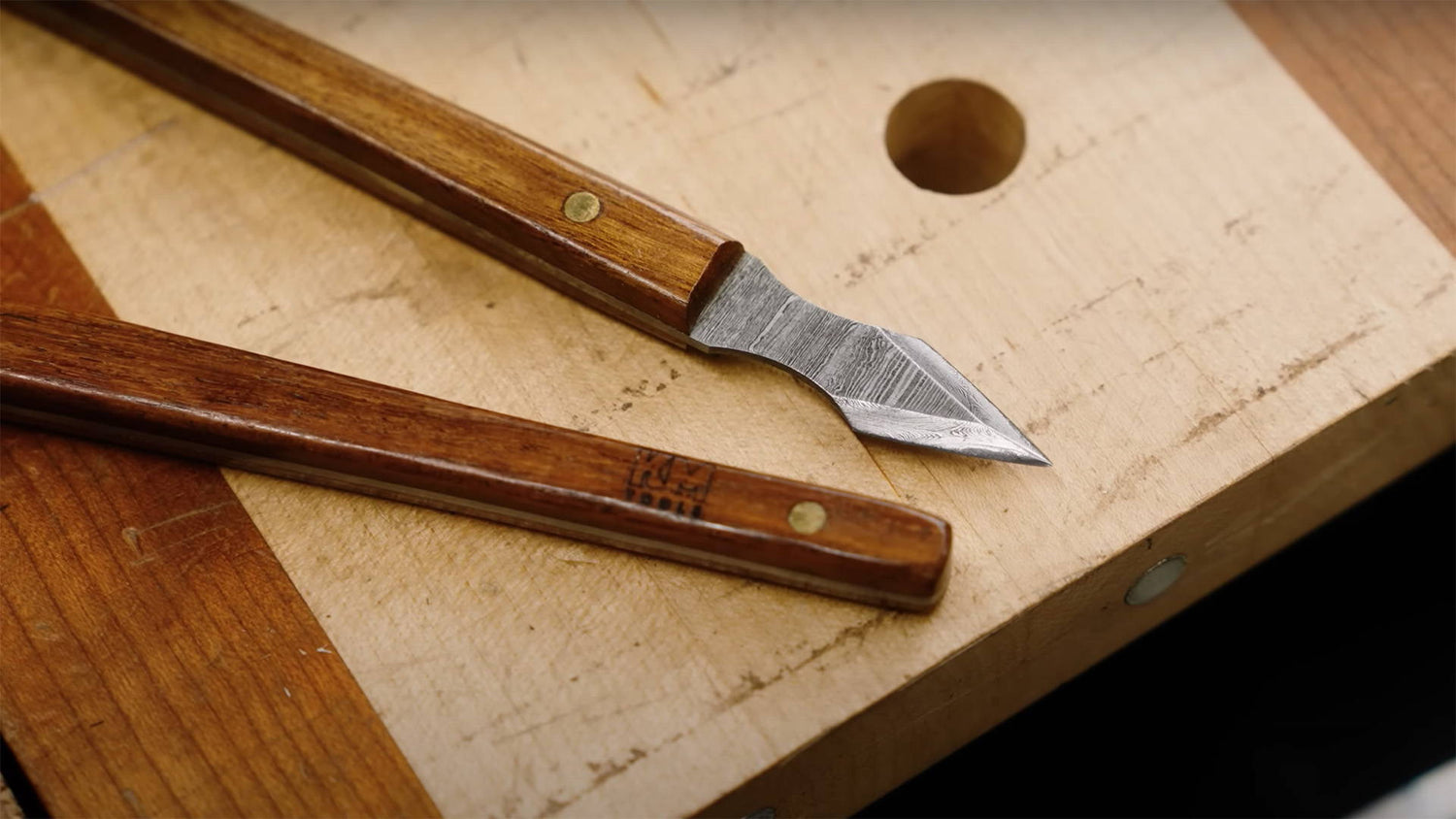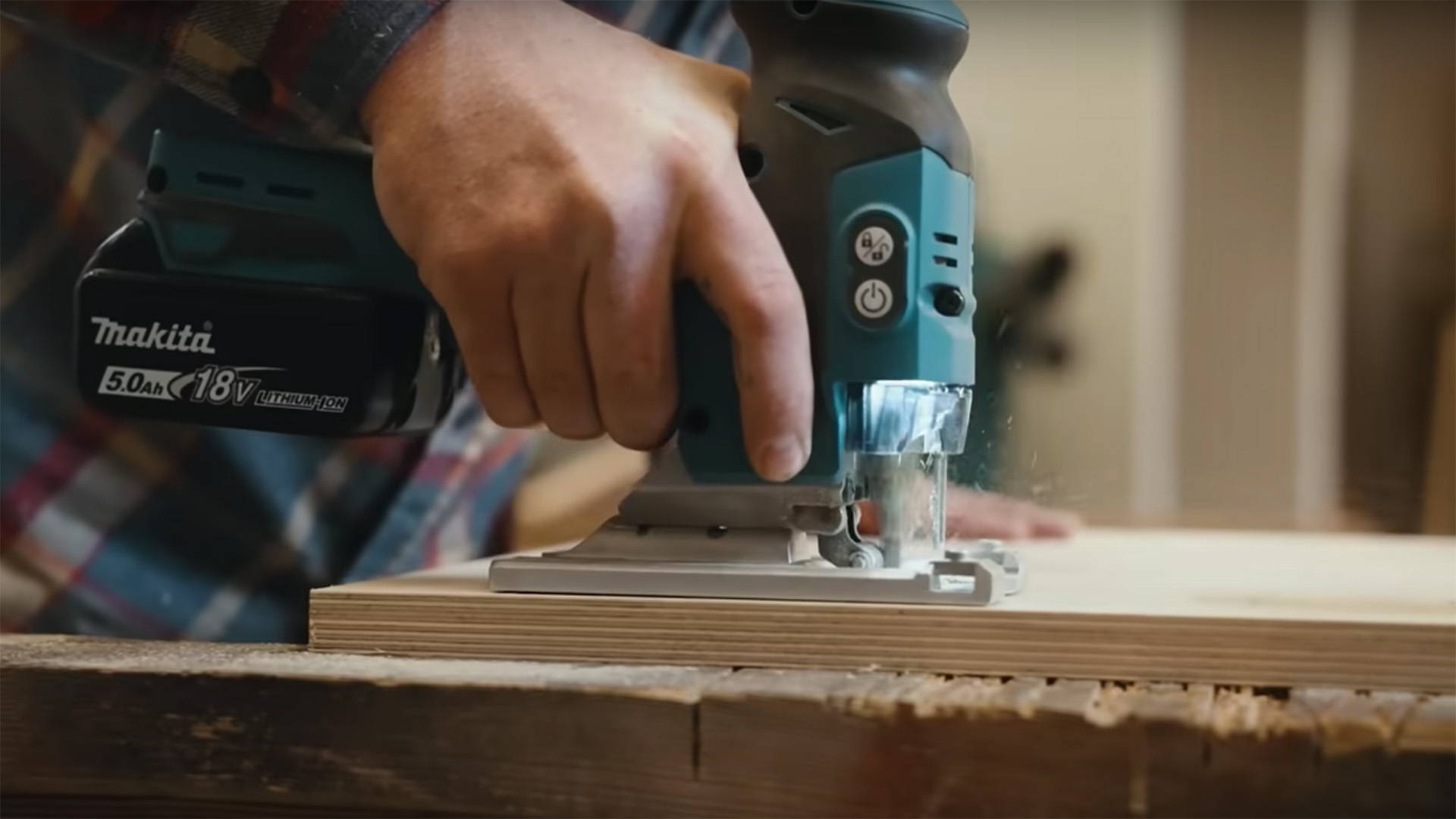There are a lot of ways to mark layout lines. Pens, pencils, chalk, walnut boogers…
But in my mind, none improves your accuracy as much as a marking knife.
That’s certainly been true for me.
When I first started woodworking, I struggled to mark accurate layout lines and make accurate cuts.
But when I started using a marking knife, it suddenly all clicked (literally, as you’ll see below).
My layout lines were identical across all my furniture components. And my cuts were exactly where I wanted them.
And I'm willing to bet marking knives can do the same for you.
Here’s 6 reasons marking knives are so useful for woodworking.
We just launched these hand-forged Damascus Steel Marking Knives in our store…
And during our Black Friday Sale, they’re available for 50% OFF when your cart total reaches $100 or more.
Just add the Damascus Steel Marking Knife to your cart with $100 worth of other tools and the discount will automatically be applied.
1. THEY CUT ULTRA THIN LINES
Marking knives create far and away the thinnest layout lines of any marking tool.
And this is critical to consistency and accuracy.
Even the thinnest pencil lines have thickness to them. Meaning you need to either leave, halve, or take the line — and do it exactly the same for every cut.
It can be done. But it’s tricky.
Marking knife lines are so thin, there’s no question of “where” to cut it. Just set your tool blades in the line and you’re good.
For intricate joinery like dovetails, it’s hard to stress how helpful this is.
2. THEY HAVE NO OFFSET
Say you’re using a square to mark a layout line.
Even with super thin mechanical pencils, you’ll get a slight offset from the edge of the ruler or square blade.
Maybe with a super sharpened pencil it can be exact — but as soon as it dulls the slightest, the offset is back.
With a marking knife, there’s no offset from your square.
The blade can mark a line perfectly flush with the edge…
Exactly where you want it.
BONUS TIP
Any good square will have etched graduations. And the edge of your marking knife can click right into them.
It’s an easy way to layout exact distances when you need them.
3. IT’S EASY TO FIND YOUR LINES AGAIN
Marking knives give you a physical reference of your line.
If you need to find it again, there’s no eyeballing. The tip of the knife will literally click right into place.
This is really useful if you need to wrap a line around a board, like for marking the bottom of a tenon.
And can also be a lifesaver if you have to step out of the shop for a quick emergency burrito.
4. THEY CREATE A PHYSICAL REFERENCE FOR YOUR TOOLS
This is one of the biggest reasons I recommend marking knives.
They create a physical mark other tools can register in.
You can set the tip of your chisel in the line and know your cut will be square and right on the money.
Or if you’re making a crosscut on a table saw, you can adjust your board until the tooth of the blade clicks right into the line. (Here’s what I mean).
This physical reference helps you get more accurate cuts with hand saws, table saws, routers, bandsaws, and a ton of other tools.
BONUS TIP
Need to drill a hole in an exact location? Use your marking knife to cut an “X” intersecting at that point.
You can then use those two lines to register your awl or center punch, which will guide your forstner bits right into position.
5. THEY SEVER WOOD FIBERS
By severing wood fibers, marking knife lines create a “barrier” to stop tearout or chipping.
Say you’re chopping away waste with a chisel. If you take off a little too much material, the wood might chip out on the wrong side of your line.
But as long as your marking knife line is deep enough, it’ll stop any fibers from tearing out beyond it.
This is super useful if you're shaping round tenons with a chisel… or whenever you’re clearing waste in a mortise or between dovetails.
6. THEY JUST LOOK COOL
From Harry Potter wands to bushcraft survival blades, there’s an endless array of marking knife styles.
They just look friggin’ cool. And I’ve built a serious collection over the years.
One of the coolest ones I’ve found are these Damascus Steel Marking Knives we now carry in our store.
The double-bevel blade is perfect for left and right-handed users alike — and the swirling Damascus steel design is mesmerizing.
Right now, you can get them for 50% OFF when you spend $100 or more during our ongoing Black Friday Sale…
So if you want to mark with style — check ‘em out.
MARKING KNIFE CONS
The one con to marking knives is you might have lines left where you don’t want them.
The good news is they're pretty easy to remove.
You can typically get rid of marking knife lines with a card scraper, hand plane, or chisel.
Alternatively, you can do a guide layout with pencil first, then only scribe marking knife lines where you’ll actually make cuts.
For me, all the pros heavily outweigh this one con — especially since it’s pretty easy to avoid with a bit of planning (and planing).
And some people even think the marking knife lines on dovetails make them look more hand cut!
MAKE YOUR MARK
No matter where you are in your journey, a marking knife can help get you to the next level of woodworking accuracy.
Using them made a massive difference in my ability when I first got started…
And I guarantee they can do the same for you.
Looking for an affordable, no-nonsense marking knife? This one does everything you need.
What’s your favorite marking tool for woodworking? Let us know in the comments below!
Follow us on Instagram @katzmosestools, on TikTok @katzmoseswoodworking, and check out my YouTube channel for more great woodworking content...
And as always, STAY SAFE IN THE SHOP!











2 comments
loghome shoppe
Woodworking has practical applications in creating furniture, cabinetry, flooring, and structural elements in buildings
Woodworking has practical applications in creating furniture, cabinetry, flooring, and structural elements in buildings
John McBratney
Jonathan, I agree 100% with your thoughts on marking kniives and accuracy. I use them all the time, sometimes I highlight the shallow cut with a sharp pencil, just lightly. I have an iGaging double bevel marking knife. Good steel but not Damascus. I also have a Japanese marking knife that has I think a picture of the maker on it Ikeuchi Hamono. This knife comes in a bamboo handle/case. You pull the case/cover off and the remaining case stays as a handle. It is definitely Damascus steel and lethally sharp. It has a one sided slant blade. Wish I could read the Japanese script on it and the case/packaging.
Jonathan, I agree 100% with your thoughts on marking kniives and accuracy. I use them all the time, sometimes I highlight the shallow cut with a sharp pencil, just lightly. I have an iGaging double bevel marking knife. Good steel but not Damascus. I also have a Japanese marking knife that has I think a picture of the maker on it Ikeuchi Hamono. This knife comes in a bamboo handle/case. You pull the case/cover off and the remaining case stays as a handle. It is definitely Damascus steel and lethally sharp. It has a one sided slant blade. Wish I could read the Japanese script on it and the case/packaging.